Input interpretation

NaOH sodium hydroxide + F_2 fluorine ⟶ H_2O water + O_2 oxygen + NaF sodium fluoride
Balanced equation
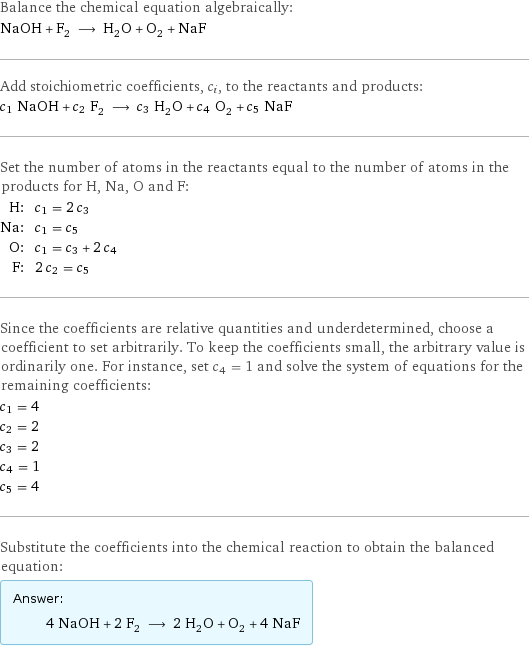
Balance the chemical equation algebraically: NaOH + F_2 ⟶ H_2O + O_2 + NaF Add stoichiometric coefficients, c_i, to the reactants and products: c_1 NaOH + c_2 F_2 ⟶ c_3 H_2O + c_4 O_2 + c_5 NaF Set the number of atoms in the reactants equal to the number of atoms in the products for H, Na, O and F: H: | c_1 = 2 c_3 Na: | c_1 = c_5 O: | c_1 = c_3 + 2 c_4 F: | 2 c_2 = c_5 Since the coefficients are relative quantities and underdetermined, choose a coefficient to set arbitrarily. To keep the coefficients small, the arbitrary value is ordinarily one. For instance, set c_4 = 1 and solve the system of equations for the remaining coefficients: c_1 = 4 c_2 = 2 c_3 = 2 c_4 = 1 c_5 = 4 Substitute the coefficients into the chemical reaction to obtain the balanced equation: Answer: | | 4 NaOH + 2 F_2 ⟶ 2 H_2O + O_2 + 4 NaF
Structures

+ ⟶ + +
Names

sodium hydroxide + fluorine ⟶ water + oxygen + sodium fluoride
Reaction thermodynamics
Enthalpy
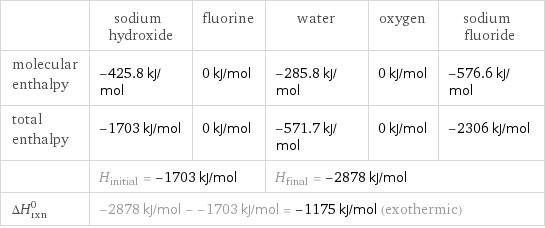
| sodium hydroxide | fluorine | water | oxygen | sodium fluoride molecular enthalpy | -425.8 kJ/mol | 0 kJ/mol | -285.8 kJ/mol | 0 kJ/mol | -576.6 kJ/mol total enthalpy | -1703 kJ/mol | 0 kJ/mol | -571.7 kJ/mol | 0 kJ/mol | -2306 kJ/mol | H_initial = -1703 kJ/mol | | H_final = -2878 kJ/mol | | ΔH_rxn^0 | -2878 kJ/mol - -1703 kJ/mol = -1175 kJ/mol (exothermic) | | | |
Gibbs free energy
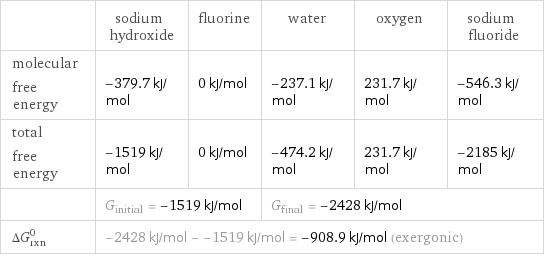
| sodium hydroxide | fluorine | water | oxygen | sodium fluoride molecular free energy | -379.7 kJ/mol | 0 kJ/mol | -237.1 kJ/mol | 231.7 kJ/mol | -546.3 kJ/mol total free energy | -1519 kJ/mol | 0 kJ/mol | -474.2 kJ/mol | 231.7 kJ/mol | -2185 kJ/mol | G_initial = -1519 kJ/mol | | G_final = -2428 kJ/mol | | ΔG_rxn^0 | -2428 kJ/mol - -1519 kJ/mol = -908.9 kJ/mol (exergonic) | | | |
Entropy
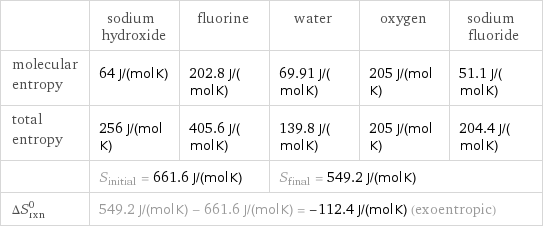
| sodium hydroxide | fluorine | water | oxygen | sodium fluoride molecular entropy | 64 J/(mol K) | 202.8 J/(mol K) | 69.91 J/(mol K) | 205 J/(mol K) | 51.1 J/(mol K) total entropy | 256 J/(mol K) | 405.6 J/(mol K) | 139.8 J/(mol K) | 205 J/(mol K) | 204.4 J/(mol K) | S_initial = 661.6 J/(mol K) | | S_final = 549.2 J/(mol K) | | ΔS_rxn^0 | 549.2 J/(mol K) - 661.6 J/(mol K) = -112.4 J/(mol K) (exoentropic) | | | |
Equilibrium constant
![Construct the equilibrium constant, K, expression for: NaOH + F_2 ⟶ H_2O + O_2 + NaF Plan: • Balance the chemical equation. • Determine the stoichiometric numbers. • Assemble the activity expression for each chemical species. • Use the activity expressions to build the equilibrium constant expression. Write the balanced chemical equation: 4 NaOH + 2 F_2 ⟶ 2 H_2O + O_2 + 4 NaF Assign stoichiometric numbers, ν_i, using the stoichiometric coefficients, c_i, from the balanced chemical equation in the following manner: ν_i = -c_i for reactants and ν_i = c_i for products: chemical species | c_i | ν_i NaOH | 4 | -4 F_2 | 2 | -2 H_2O | 2 | 2 O_2 | 1 | 1 NaF | 4 | 4 Assemble the activity expressions accounting for the state of matter and ν_i: chemical species | c_i | ν_i | activity expression NaOH | 4 | -4 | ([NaOH])^(-4) F_2 | 2 | -2 | ([F2])^(-2) H_2O | 2 | 2 | ([H2O])^2 O_2 | 1 | 1 | [O2] NaF | 4 | 4 | ([NaF])^4 The equilibrium constant symbol in the concentration basis is: K_c Mulitply the activity expressions to arrive at the K_c expression: Answer: | | K_c = ([NaOH])^(-4) ([F2])^(-2) ([H2O])^2 [O2] ([NaF])^4 = (([H2O])^2 [O2] ([NaF])^4)/(([NaOH])^4 ([F2])^2)](../image_source/9e45b825a664bc6d5a79f85946e2ffb6.png)
Construct the equilibrium constant, K, expression for: NaOH + F_2 ⟶ H_2O + O_2 + NaF Plan: • Balance the chemical equation. • Determine the stoichiometric numbers. • Assemble the activity expression for each chemical species. • Use the activity expressions to build the equilibrium constant expression. Write the balanced chemical equation: 4 NaOH + 2 F_2 ⟶ 2 H_2O + O_2 + 4 NaF Assign stoichiometric numbers, ν_i, using the stoichiometric coefficients, c_i, from the balanced chemical equation in the following manner: ν_i = -c_i for reactants and ν_i = c_i for products: chemical species | c_i | ν_i NaOH | 4 | -4 F_2 | 2 | -2 H_2O | 2 | 2 O_2 | 1 | 1 NaF | 4 | 4 Assemble the activity expressions accounting for the state of matter and ν_i: chemical species | c_i | ν_i | activity expression NaOH | 4 | -4 | ([NaOH])^(-4) F_2 | 2 | -2 | ([F2])^(-2) H_2O | 2 | 2 | ([H2O])^2 O_2 | 1 | 1 | [O2] NaF | 4 | 4 | ([NaF])^4 The equilibrium constant symbol in the concentration basis is: K_c Mulitply the activity expressions to arrive at the K_c expression: Answer: | | K_c = ([NaOH])^(-4) ([F2])^(-2) ([H2O])^2 [O2] ([NaF])^4 = (([H2O])^2 [O2] ([NaF])^4)/(([NaOH])^4 ([F2])^2)
Rate of reaction
![Construct the rate of reaction expression for: NaOH + F_2 ⟶ H_2O + O_2 + NaF Plan: • Balance the chemical equation. • Determine the stoichiometric numbers. • Assemble the rate term for each chemical species. • Write the rate of reaction expression. Write the balanced chemical equation: 4 NaOH + 2 F_2 ⟶ 2 H_2O + O_2 + 4 NaF Assign stoichiometric numbers, ν_i, using the stoichiometric coefficients, c_i, from the balanced chemical equation in the following manner: ν_i = -c_i for reactants and ν_i = c_i for products: chemical species | c_i | ν_i NaOH | 4 | -4 F_2 | 2 | -2 H_2O | 2 | 2 O_2 | 1 | 1 NaF | 4 | 4 The rate term for each chemical species, B_i, is 1/ν_i(Δ[B_i])/(Δt) where [B_i] is the amount concentration and t is time: chemical species | c_i | ν_i | rate term NaOH | 4 | -4 | -1/4 (Δ[NaOH])/(Δt) F_2 | 2 | -2 | -1/2 (Δ[F2])/(Δt) H_2O | 2 | 2 | 1/2 (Δ[H2O])/(Δt) O_2 | 1 | 1 | (Δ[O2])/(Δt) NaF | 4 | 4 | 1/4 (Δ[NaF])/(Δt) (for infinitesimal rate of change, replace Δ with d) Set the rate terms equal to each other to arrive at the rate expression: Answer: | | rate = -1/4 (Δ[NaOH])/(Δt) = -1/2 (Δ[F2])/(Δt) = 1/2 (Δ[H2O])/(Δt) = (Δ[O2])/(Δt) = 1/4 (Δ[NaF])/(Δt) (assuming constant volume and no accumulation of intermediates or side products)](../image_source/afde0b5ecfbf7b4f5107ce3decf47018.png)
Construct the rate of reaction expression for: NaOH + F_2 ⟶ H_2O + O_2 + NaF Plan: • Balance the chemical equation. • Determine the stoichiometric numbers. • Assemble the rate term for each chemical species. • Write the rate of reaction expression. Write the balanced chemical equation: 4 NaOH + 2 F_2 ⟶ 2 H_2O + O_2 + 4 NaF Assign stoichiometric numbers, ν_i, using the stoichiometric coefficients, c_i, from the balanced chemical equation in the following manner: ν_i = -c_i for reactants and ν_i = c_i for products: chemical species | c_i | ν_i NaOH | 4 | -4 F_2 | 2 | -2 H_2O | 2 | 2 O_2 | 1 | 1 NaF | 4 | 4 The rate term for each chemical species, B_i, is 1/ν_i(Δ[B_i])/(Δt) where [B_i] is the amount concentration and t is time: chemical species | c_i | ν_i | rate term NaOH | 4 | -4 | -1/4 (Δ[NaOH])/(Δt) F_2 | 2 | -2 | -1/2 (Δ[F2])/(Δt) H_2O | 2 | 2 | 1/2 (Δ[H2O])/(Δt) O_2 | 1 | 1 | (Δ[O2])/(Δt) NaF | 4 | 4 | 1/4 (Δ[NaF])/(Δt) (for infinitesimal rate of change, replace Δ with d) Set the rate terms equal to each other to arrive at the rate expression: Answer: | | rate = -1/4 (Δ[NaOH])/(Δt) = -1/2 (Δ[F2])/(Δt) = 1/2 (Δ[H2O])/(Δt) = (Δ[O2])/(Δt) = 1/4 (Δ[NaF])/(Δt) (assuming constant volume and no accumulation of intermediates or side products)
Chemical names and formulas
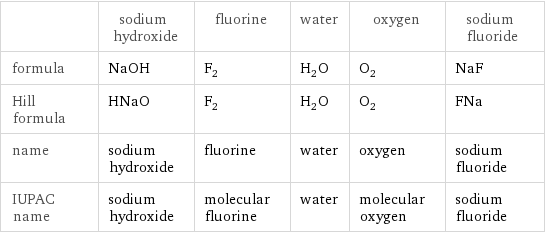
| sodium hydroxide | fluorine | water | oxygen | sodium fluoride formula | NaOH | F_2 | H_2O | O_2 | NaF Hill formula | HNaO | F_2 | H_2O | O_2 | FNa name | sodium hydroxide | fluorine | water | oxygen | sodium fluoride IUPAC name | sodium hydroxide | molecular fluorine | water | molecular oxygen | sodium fluoride
Substance properties

| sodium hydroxide | fluorine | water | oxygen | sodium fluoride molar mass | 39.997 g/mol | 37.996806326 g/mol | 18.015 g/mol | 31.998 g/mol | 41.98817244 g/mol phase | solid (at STP) | gas (at STP) | liquid (at STP) | gas (at STP) | solid (at STP) melting point | 323 °C | -219.6 °C | 0 °C | -218 °C | 993 °C boiling point | 1390 °C | -188.12 °C | 99.9839 °C | -183 °C | 1700 °C density | 2.13 g/cm^3 | 0.001696 g/cm^3 (at 0 °C) | 1 g/cm^3 | 0.001429 g/cm^3 (at 0 °C) | 2.558 g/cm^3 solubility in water | soluble | reacts | | | surface tension | 0.07435 N/m | | 0.0728 N/m | 0.01347 N/m | dynamic viscosity | 0.004 Pa s (at 350 °C) | 2.344×10^-5 Pa s (at 25 °C) | 8.9×10^-4 Pa s (at 25 °C) | 2.055×10^-5 Pa s (at 25 °C) | 0.00105 Pa s (at 1160 °C) odor | | | odorless | odorless | odorless
Units
